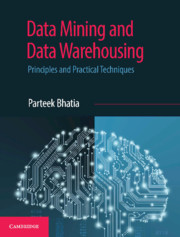Book contents
- Frontmatter
- Dedication
- Contents
- List of Figures
- List of Tables
- Preface
- Acknowledgments
- 1 Beginning with Machine Learning
- 2 Introduction to Data Mining
- 3 Beginning with Weka and R Language
- 4 Data Preprocessing
- 5 Classification
- 6 Implementing Classification in Weka and R
- 7 Cluster Analysis
- 8 Implementing Clustering with Weka and R
- 9 Association Mining
- 10 Implementing Association Mining with Weka and R
- 11 Web Mining and Search Engines
- 12 Data Warehouse
- 13 Data Warehouse Schema
- 14 Online Analytical Processing
- 15 Big Data and NoSQL
- Index
- Colour Plates
15 - Big Data and NoSQL
Published online by Cambridge University Press: 26 April 2019
- Frontmatter
- Dedication
- Contents
- List of Figures
- List of Tables
- Preface
- Acknowledgments
- 1 Beginning with Machine Learning
- 2 Introduction to Data Mining
- 3 Beginning with Weka and R Language
- 4 Data Preprocessing
- 5 Classification
- 6 Implementing Classification in Weka and R
- 7 Cluster Analysis
- 8 Implementing Clustering with Weka and R
- 9 Association Mining
- 10 Implementing Association Mining with Weka and R
- 11 Web Mining and Search Engines
- 12 Data Warehouse
- 13 Data Warehouse Schema
- 14 Online Analytical Processing
- 15 Big Data and NoSQL
- Index
- Colour Plates
Summary
Chapter Objectives
✓ To discuss the major issues of relational databases
✓ To understand the need for NoSQL
✓ To comprehend the characteristics of NoSQL
✓ To understand different data models of NoSQL
✓ To understand the concept of the CAP theorem
✓ To discuss the future of NoSQL
After about half a century of dominance of relational database, the current excitement about NoSQL databases comes as a big surprise. In this chapter, we'll explore the challenges faced by relational databases due to changing technological paradigms and why the current rise of NoSQL databases is not a flash in the pan.
Let us start our discussion by looking at relational databases.
The Rise of Relational Databases
Dr E. F Codd proposed the relational model in 1969. It was soon adopted by the mainstream software industries due to its simplicity and efficiency replacing hierarchical and network models that were prevalent at that time. The timeline showing the rise of the relational model is depicted in Figure 15.1.
The reasons for the success of relational databases were their simplicity, the power of SQL, support for transaction management, concurrency control, and recovery management.
Major Issues with Relational Databases
The relational data model organizes data in rows and columns that are arranged in a tabular form. In the relational model, a row is known as a tuple which is a set of key-value pairs and a relation is a set of these tuples. All operations in SQL consume and return relations. This foundation based on relations provides a certain elegance and simplicity, but it also suffers some limitations. The values in a relational tuple have to be simple (atomic)—they cannot contain any structure, such as a nested record or a list.
This limitation is not true for in-memory data structures, which can take on much richer structures than relations. As a result, if you want to use a richer in-memory data structure, you would have to translate it to a relational representation to store it on disk. This problem is known as impedance mismatch i.e. two different representations that require inter-translation as shown in Figure 15.2.
The impedance mismatch is a major source of frustration for application developers. In the 1990s many experts believed that impedance mismatch would lead to relational databases being replaced with databases that replicate the in-memory data structures to disk.
- Type
- Chapter
- Information
- Data Mining and Data WarehousingPrinciples and Practical Techniques, pp. 442 - 466Publisher: Cambridge University PressPrint publication year: 2019

